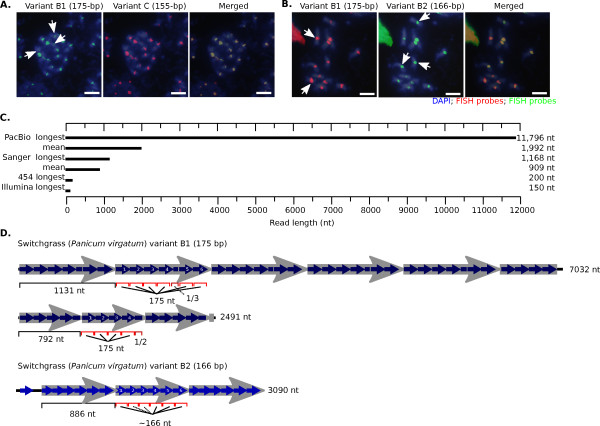Figure 8.

Pacific Biosciences sequencing shows homogeneity of repeat arrays and detects long higher order repeat structures. (a) Switchgrass variant B1 hybridized to all switchgrass chromosomes, whereas witchgrass variant C hybridized to all but three switchgrass chromosomes. The three chromosomes that only showed hybridization of variant B1 (arrows) were stained green (see merged). (b) Although both switchgrass variants B1 and B2 co-hybridize to all switchgrass chromosomes, the hybridization signal showed a chromosome-specific pattern. The arrows highlight chromosomes with stronger hybridization signal for one sub-variant over the other. (c) The strength of PacBio sequencing is the extreme length of a small fraction of the reads. In the AP13 switchgrass PacBio sequencing run, the longest inserted sequence was almost 12 kbp in length, although the mean of all the PacBio reads was about 2 kbp. Sanger reads are shorter, but have a more consistent length, whereas both Illumina and 454 reads are very short and very homogeneous in length (longest reads in our study only shown). (d) Although no repeat variant mixing was detected in the PacBio reads, several HOR structures were found in longer PacBio reads. These HOR structures consisted of a mixture of complete and trunctated repeats. Two switchgrass variant B1 centromere reads with higher order structure and one switchgrass variant B2 centromere repeat are shown. The 1,131-bp HOR structure consisted of six repeat monomers and a truncated repeat (about one-third the size of 175 bp repeat). In total, five-and-half copies of the 1,131-bp repeat were found within the 7 kbp read. One variant B2-containing read is shown, containing three copies of a 886-bp HOR structure (composed of six 166-bp repeats).
